From Albuquerque to Las Cruces, the Land of Enchantment is home to some amazing birds. With 558 species observed on ebird, New Mexico’s changing seasons and vast geography provide for a diverse habitat. In this post we’ll review 30 of the most common and colorful birds in New Mexico along with some helpful data on when and where to find them.
We even sampled 5 years of aggregate data from ebird’s New Mexico checklists to compile easy-to-use statistics and graphs to help identify each bird species. So whether you’re just watching the backyard bird feeder or venturing to birding hotspots like Bosque del Apache or Bitter Lake – we’ll have you ready to start bird watching like a professional.
American Robin
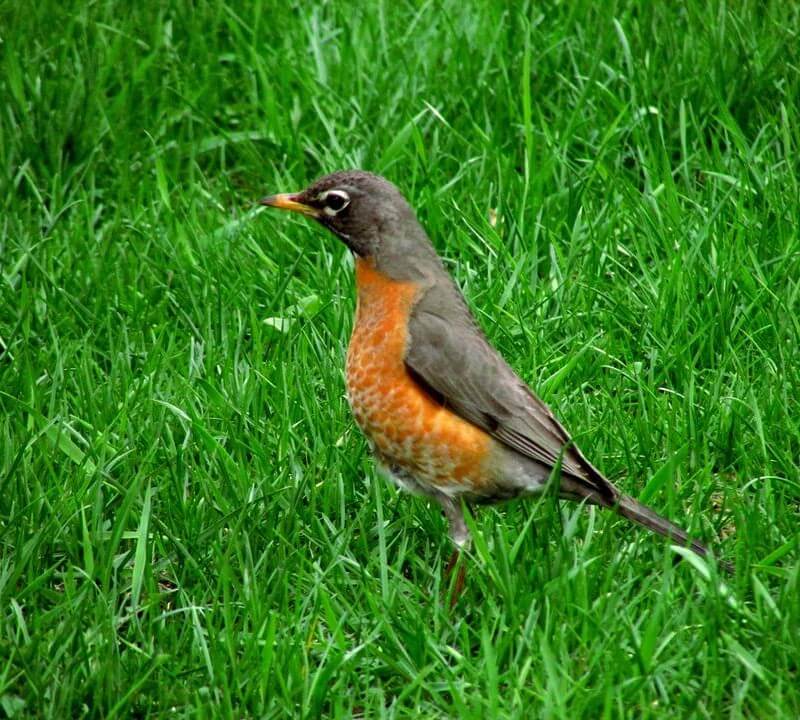
Abundant throughout the entire country and commonly a welcome indicator of spring in northern states. The American Robin is a common sight in New Mexico.
- Turdus migratorius
- Size: 9-11″ (22.5-28cm)
- NM Checklist Frequency High: 37% in October
- NM Checklist Frequency Low: 18% in August
Identification and Color: Reddish-brown breast (almost looks pot-bellied) and grey back. The female usually has a lighter plumage than the male. Males have a darker black head.
Habitat and Behavior: The American Robin is found in open woodlands, gardens, and parks. It often forages for food on the ground cocking its head to the side in an effort to find worms. When it’s not eating, the American Robin can often be seen perched on a branch singing its cheerful song.
Diet: The American Robin feeds on insects, worms, berries, and fruits.
Black-billed magpie

The Black-billed magpie can be seen year-round in New Mexico.
- Pica hudsonia
- Size: 24″ (61 cm)
- NM Checklist Frequency High: 6% in October
- NM Checklist Frequency Low: 3% in January
Identification and Color: Black-billed magpies have black heads with two white patches along the body and blue-green iridescent wings. In flight, the white tips and blue-green colors make a striking image. Very long tail feathers and thick short bills. Fairly large bird between 17 and 24 inches in length.
Habitat and Behavior: Found in the upper northwest and into Canada. A social bird that can be found in large groups. Likes farmland, forest edges, and other semi-open areas. Generally does not migrate far if at all. Will forage on the ground.
Diet: The Black-billed magpie is omnivorous with a varied diet. Enjoys insects, carrion, berries, and seeds.
Black-capped Chickadee

Black-capped Chickadees are small songbirds commonly found at feeders and nest boxes. Year-round residents of New Mexico.
- Poecile atricapillus
- Size: 5.5″ (14 cm)
- NM Checklist Frequency High: 8% in September
- NM Checklist Frequency Low: 4% in June
Identification and Color: Easily distinguished by their black caps and white cheeks. They have grey bodies with light grey wings and tail feathers.
Habitat and Behavior: Typically inhabit woodlands where there are plenty of trees for them to nest and forage in. Commonly found in suburban areas and parks. Has no issue with harsh winters. Black-capped Chickadees are not timid birds and can easily be attracted to backyard bird feeders
Diet: Consists mainly of insects and other small invertebrates like caterpillars. Chickadees will also eat seeds and berries, especially in the winter months when food is scarce.
Bushtit
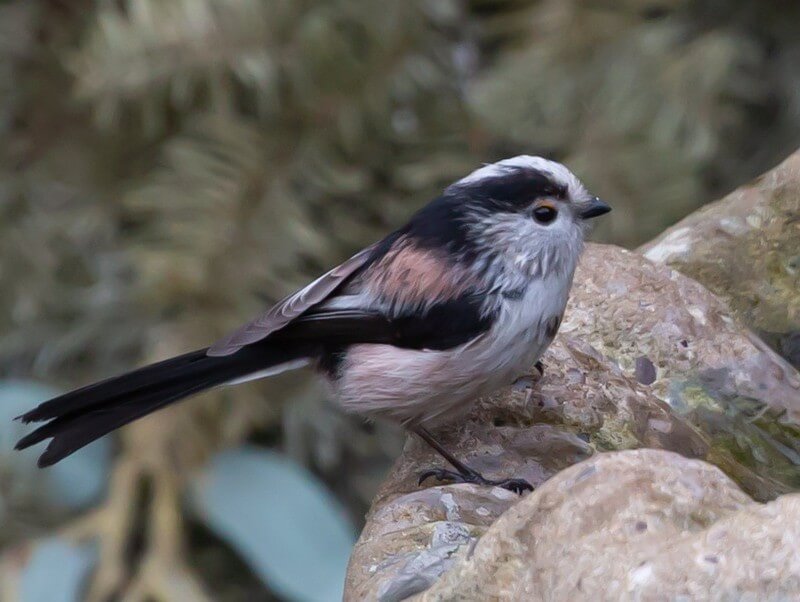
The Bushtit is a year-round resident of New Mexico.
- Psaltriparus minimus
- Size: 4″ (10 cm)
- NM Checklist Frequency High: 16% in April
- NM Checklist Frequency Low: 8% in November
Identification and Color: The Bushtit is a lightly colored bird. Gray and white from the top of their heads to their backsides, a light brown patch on the face, and lighter brown and grey on their belly sides. Some males may have some black face markings. Tiny but plump birds with long tails and short bills.
Habitat and Behavior: Located along the west coast and southwest states. Generally permanent residents, but some in higher elevations may move for the season. Favor oak forests, wooded, or brushy areas. They move quickly and within groups and can be seen hanging upside down.
Diet: Bushtits enjoy tiny insects like ants, aphids, and small beetles. They will also eat berries and sometimes seeds.
Canyon Towhee
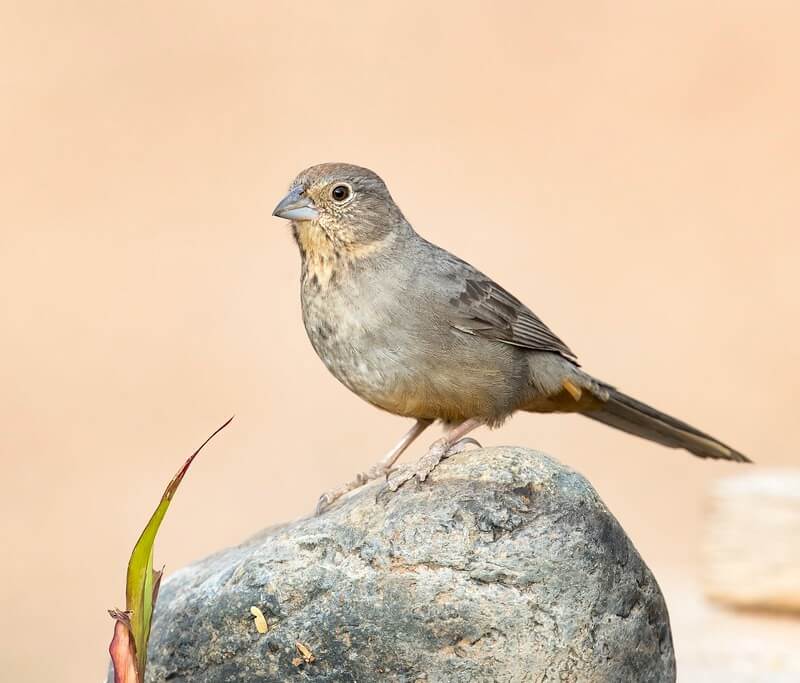
The Canyon Towhee can be seen year-round in New Mexico.
- Melozone fusca
- Size: 8″ (20 cm)
- NM Checklist Frequency High: 15% in February
- NM Checklist Frequency Low: 10% in June
Identification and Color: These large sparrow birds have long tails, chunky bodies, and rounded wings. They are primarily brown with reddish under tails, throats, and crowns. Will grow to be between 8 and 9 inches long.
Habitat and Behavior: Canyon Towhees are found primarily in the southwest. They prefer desert grasslands, brushy areas, and canyons. Will run along the ground or between bushes looking for food.
Diet: Mostly seeds and insects. Primarily seeds in the winter and insects in the summer. Will also eat berries and small fruits.
Curve-billed Thrasher

The Curve-billed Thrasher is a year-round resident of New Mexico.
- Toxostoma curvirostre
- Size: 11″ (28 cm)
- NM Checklist Frequency High: 13% in October
- NM Checklist Frequency Low: 9% in June
Identification and Color: The Curve-billed Thrasher is a long and slim bird between 10 and 11 inches long. Has bright yellow eyes that stand out from their gray-brown bodies with peach undersides. They have long, curved bills and thick legs.
Habitat and Behavior: Found in the southwest for all seasons, they prefer desert areas like brushlands with little plant life. Primarily forage on the ground, digging with their curved bills. These birds can be found foraging or perched on shrubs or cacti.
Diet: The Curve-billed Thrasher enjoys insects like larvae, grasshoppers, and beetles. Will also feed on berries and seeds from cacti.
Dark-eyed Junco

The Dark-eyed Junco is a small, sparrow-like bird that is one of New Mexico’s most common winter birds.
- Junco hyemalis
- Size: 6″ (15 cm)
- NM Checklist Frequency High: 80% in December
- NM Checklist Frequency Low: 5% in June
Identification and Color: Rounded dark head and eyes. Charcoal back and white breast.
Habitat and Behavior: Enjoys a variety of wooded habitats throughout Canada and the northern United States. Dark-eyed Juncos are typically found in open woods, forest edges, weedy fields, and backyards. In winter they often form flocks and can be seen feeding on the ground beneath bird feeders.
Diet: Dark-eyed Juncos eat mostly insects and seeds.
Eurasian Collared-Dove

The Eurasian Collared-Dove is most often seen during the summer months in New Mexico.
- Streptopelia decaocto
- Size: 13″ (33 cm)
- NM Checklist Frequency High: 24% in May
- NM Checklist Frequency Low: 13% in November
Identification and Color: The Eurasian Collared-Dove has a light grey to brown head and a light brown body. They have a distinct black mark around the back of their neck and some white patches on their tail. They have rounded bodies and small heads. Rounded wings and squared tails. Their bills are slender with a slight curve.
Habitat and Behavior: Found all over the United States with no consistent migration. Can be found in urban areas and open farmland as well. When walking they can be seen bobbing their heads and flicking their tails. Will mainly forage on the ground.
Diet: The Eurasian Collared-Dove enjoys seeds from plants and waste grain. Will also eat some berries or insects.
European Starling

The European Starling is native to Europe but was introduced to North America in the late 1800’s. Considered an invasive species, they are a common backyard bird in New Mexico.
- Sturnus vulgaris
- Size: 8.5″ (22 cm)
- NM Checklist Frequency High: 16% in May
- NM Checklist Frequency Low: 5% in July
Identification and Color: Small, stocky black birds with glossy feathers and a slender pointed bill. Speckled with white spots.
Habitat and Behavior: European starlings can be found in woods, fields, and other open areas. They often build their nests in trees or holes in buildings. European starlings are also known for their elaborate vocalizations, often imitating the sounds of other birds.
Diet: European starlings are opportunistic eaters and will feed on a variety of insects, fruits and seeds.
Evening Grosbeak

The Evening Grosbeak is seen year-round in New Mexico.
- Coccothraustes vespertinus
- Size: 9″ (23 cm)
- NM Checklist Frequency High: 4% in May
- NM Checklist Frequency Low: 1% in June
Identification and Color: Males are yellow and black with a white patch on their wings and yellow above their eyes. Females are primarily gray with a yellow tinge on their necks and black and white wings. Both are large with thick, conical bills.
Habitat and Behavior: The Evening Grosbeak resides mainly in the far north. Will live in both deciduous and coniferous forests. They will usually be in large flocks and forage among the tall trees.
Diet: Seeds comprise most of the Evening Grosbeak’s diet, including tree buds. Will also eat some berries and insects.
Hairy Woodpecker

The hairy woodpecker is a year-round resident of New Mexico.
- Picoides villosus
- Size: 9″ (22.5 cm)
- NM Checklist Frequency High: 10% in July
- NM Checklist Frequency Low: 6% in January
Identification and Color: The Hairy Woodpecker is a medium-sized black and white bird with a long bill, small head, and a long tail. Males have a small red patch on the back of the crown.
Habitat and Behavior: Prefers a dense forest. These woodpeckers are fairly common in wooded areas in the across the United States. Hairy Woodpeckers are known to be very curious and will often explore their surroundings by pecking at trees and wooded objects. (Ideally trees and not your house!)
Diet: Mainly insects and insect larvae found in trees. Will also eat berries, seeds, and nuts.
House Finch

The House Finch is a common bird across North America, seen year-round in New Mexico.
- Carpodacus mexicanus
- Size: 5″ (13 cm)
- NM Checklist Frequency High: 57% in February
- NM Checklist Frequency Low: 44% in September
Identification and Color: Fairly small, measuring only about 5-6 inches long. House Finches are relatively easy to identify thanks to their characteristic red plumage near the eyes and throat. Males are typically redder than females, but both genders have distinctive streaks on their breast and belly.
Habitat and Behavior: House Finches are found in a variety of habitats, including woods, gardens, and open fields. A rather social bird that often travels in flocks. Can often be seen perching on power lines or fences in suburban areas.
Diet: House Finches are primarily seed eaters, but they will also consume insects and fruit on occasion.
House Sparrow

One of the most common backyard birds in New Mexico. The House Sparrow is seen year-round.
- Passer domesticus
- Size: 6″ (15 cm)
- NM Checklist Frequency High: 26% in February
- NM Checklist Frequency Low: 16% in September
Identification and Color: A small plump bird with brown feathers and a grayish-plain breast. They have a black stripe on their face that extends from their bill to their throat. Wings are streaked with black and white.
Habitat and Behavior: Found in open areas with some trees nearby, such as farmland, parks, and suburban neighborhoods. They build their nests in holes in tree trunks or in man-made structures such as gutters, light fixtures, and nest boxes. House Sparrows are social birds that often form large flocks. You won’t be surprised to see them downtown near restaurants with outdoor seating!
Diet: House Sparrows eat mostly seeds and grains, but will also eat insects, berries, and other fruits. Happy to pick up crumbs and leftover human food where available.
Juniper Titmouse
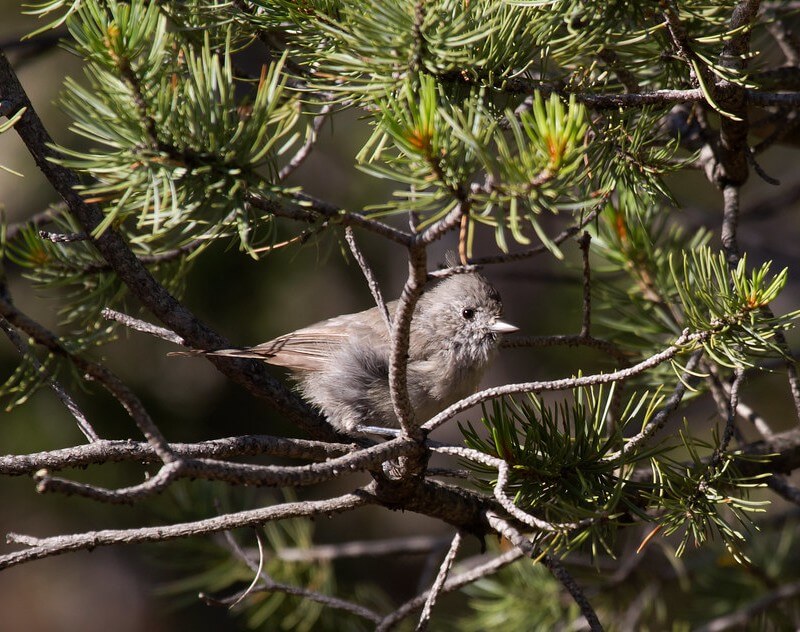
The Juniper Titmouse is a year-round resident of New Mexico.
- Baeolophus ridgwayi
- Size: 9″ (23 cm)
- NM Checklist Frequency High: 10% in September
- NM Checklist Frequency Low: 5% in November
Identification and Color: The Juniper Titmouse is a small gray songbird with stark black eyes. Undersides are often a lighter gray color. These birds have long tails and tufted crowns on their head. They have a short, thick, rounded bill.
Habitat and Behavior: Found in the southwest, they are permanent residents there. They make their homes in pinyon-juniper trees and nest high in these trees. The Juniper Titmouse will hang upside down from trees and hop between shrubs to forage.
Diet: Feeds on insects, nuts, and seeds. Will eat caterpillars, beetles, and sometimes spiders.
Lesser Goldfinch

The Lesser Goldfinch is a year-round resident of New Mexico.
- Spinus psaltria
- Size: 5″ (13 cm)
- NM Checklist Frequency High: 42% in August
- NM Checklist Frequency Low: 12% in January
Identification and Color: Males have black on top of their heads and bodies. They have a bright yellow underpart and white bars on their wings. Females have a dark top, but not black and yellow underparts that are duller than the males. These birds have short tails and long wings. They have a very short bill.
Habitat and Behavior: Found in the southern midwest and west. Mostly permanent residents in their locations, but northern birds may migrate further south. Likes to be in weedy fields, brushy areas, and can be close to streams. Can be in extremely large groups and may mix with other bird species.
Diet: The Lesser Goldfinch will eat mostly seeds but some insects too.
Mountain Chickadee
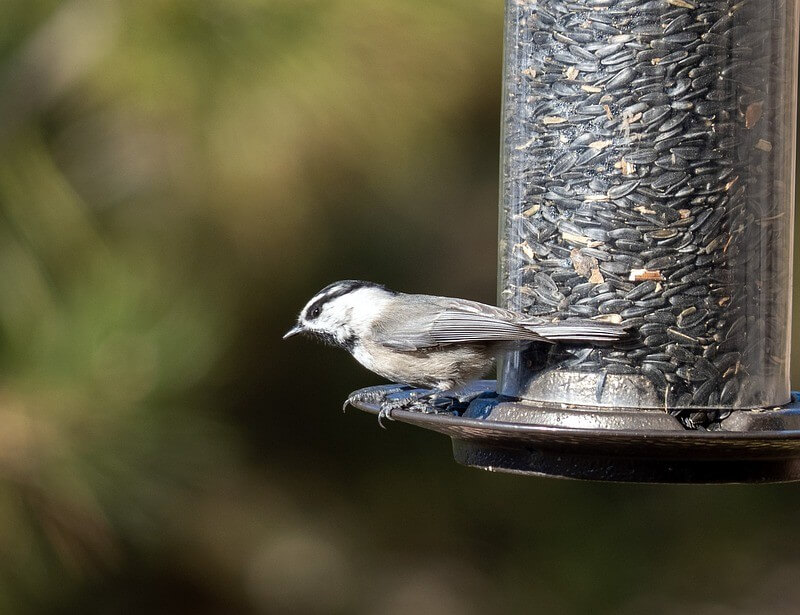
The Mountain Chickadee can be seen year-round in New Mexico.
- Poecile gambeli
- Size: 6″ (15 cm)
- NM Checklist Frequency High: 22% in December
- NM Checklist Frequency Low: 5% in June
Identification and Color: The Mountain Chickadee has a black and white head with gray on top of the body and underparts. Males and females look similar. The main identifier of the Mountain Chickadee is the white strip above the eye. They have narrow tails and rounded wings with a small and pointed bill.
Habitat and Behavior: Permanent residents of the southwest and northwest. Prefers forests that are mostly dry and mountainous. They like evergreens and high areas but can move to the lower levels in the winter. Very active and will jump around in their trees. Will join flocks of other birds when foraging in trees.
Diet: Mountain Chickadees enjoy a diet of insects, seeds, and berries. They will usually eat the insect eggs and pupae.
Mourning Dove
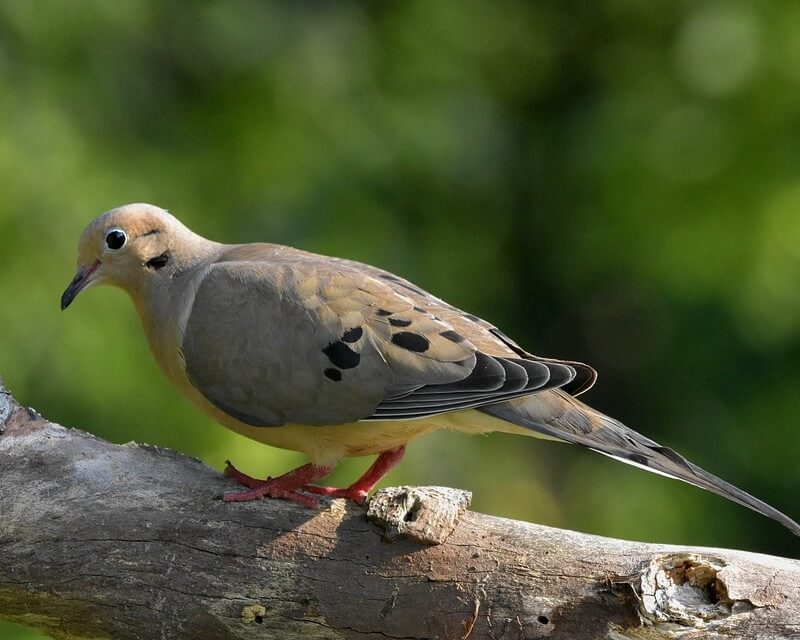
Mourning Doves are one of the most common birds in North America, and they can be found in a variety of habitats throughout New Mexico.
- Zenaida macroura
- Size: 12″ (30 cm)
- NM Checklist Frequency High: 46% in August
- NM Checklist Frequency Low: 13% in December
Identification and Color: These slender birds have long, pointed tails and a tiny head. Brown and pale gray plumage with darker streaks on the wings and back.
Habitat and Behavior: Mourning Doves are relatively quiet birds, but they can often be heard cooing softly. Mourning Doves typically nest in trees, but they will also use man-made structures such as window ledges and gutters.
Diet: The Mourning Dove primarily eat seeds, but they will also eat insects and berries
Northern Flicker
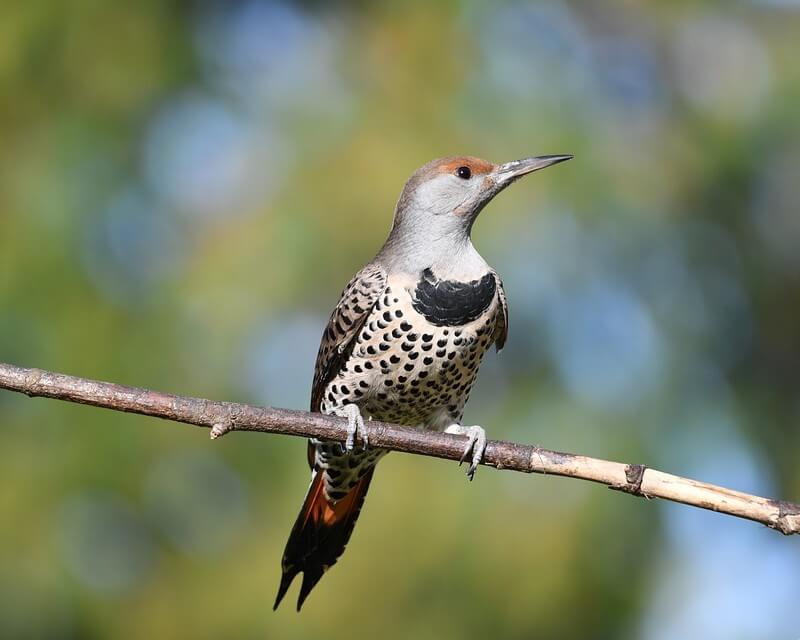
The Northern Flicker is seen year-round in New Mexico, but less common during the summer.
- Colaptes auratus
- Size: 12″ (30 cm)
- NM Checklist Frequency High: 46% in October
- NM Checklist Frequency Low: 12% in May
Identification and Color: A fairly common large woodpecker, but size is where the similarities to other woodpeckers end. The male Northern Flicker is unique with a brown back, black bars and spotted breast. All North American Flickers have white rumps. There are also two different color groups of Northern Flickers – Yellow-shafted and Red-shafted. Yellow-shafted flickers have yellow underwings. Red-shafted flickers have reddish pink underwings.
Habitat and Behavior: Northern Flickers are hole-nesting birds, often making a home in a dead tree. Can be seen hopping around the ground while foraging or latched onto a tree eyeing a spot to search for food.
Diet: Northern Flickers mainly eat insects off the ground, but will also eat berries and nuts.
Pine Siskin

The Pine Siskin is seen year-round in New Mexico.
- Spinus pinus
- Size: 5″ (13 cm)
- NM Checklist Frequency High: 18% in October
- NM Checklist Frequency Low: 7% in June
Identification and Color: The Pine Siskin is brown with black streaks all over its body. They have some yellow edges on their wings and tails. Very small birds between 4 and 5 inches in length. They have short notched tails. Their bills are sharp, short, and pointed.
Habitat and Behavior: Pine Siskins have a very odd migration and residency. Some will breed in the very far north, some will winter throughout the United States, and some are permanent residents along the United States and Canada border. Will primarily be in evergreen forests but can be found in other areas of thickets or weedy areas. Will forage in large flocks.
Diet: Seeds, vegetable matter, and some insects. Will feed on the tree, grass, and weed seeds.
Red-winged Blackbird

The Red-winged Blackbird is a year-round resident of New Mexico, especially near areas of water.
- Agelaius phoeniceus
- Size: 8.5″ (22 cm)
- NM Checklist Frequency High: 22% in April
- NM Checklist Frequency Low: 6% in September
Identification and Color: A small black bird with a striking appearance. The male has black feathers and a red patch on each wing, while the female is mostly dark brown with vertical streaks.
Habitat and Behavior: These birds are found in open areas such as marshes, meadows, and fields. Often seen near water, where they build their nests. Red-winged Blackbirds are social birds and often form large flocks.
Diet: The Red-winged Blackbird diet consists of insects, spiders, and other small invertebrates. Will also eat seeds, fruits, and berries.
Ruby-crowned Kinglet

The Ruby-crowned Kinglet is commonly seen in New Mexico during the spring and fall months.
- Regulus calendula
- Size: 4″ (11 cm)
- NM Checklist Frequency High: 25% in October
- NM Checklist Frequency Low: 2% in August
Identification and Color: The Ruby-crowned Kinglet has an olive green body with somewhat lighter underparts. They have white eye-rings and on males, the ruby red crest is only occasionally able to be seen. White and black wing bars. They are small birds with large heads and no necks. Very thin and straight bills.
Habitat and Behavior: Will breed very far north and migrates to spend the winter in the south. They like to be in tall and dense forests. Favor coniferous in the summer and deciduous in the winter because of their location. Very energetic birds that are constantly flicking their wings. They forage at many levels in the trees.
Diet: In summer the Ruby-crowned Kinglet feeds mainly on insects. During winter they will eat some berries and seeds.
Say’s Phoebe
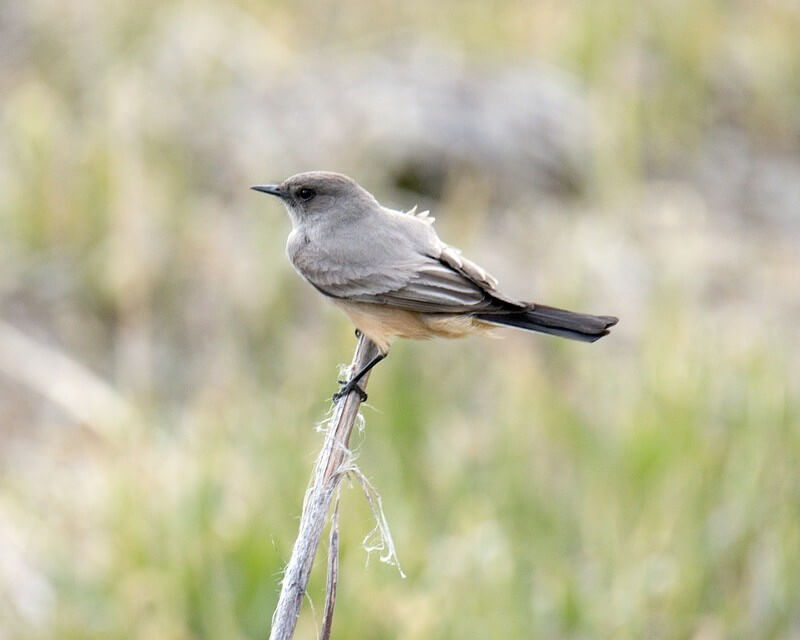
The Say’s Phoebe is a year-round resident of New Mexico.
- Sayornis saya
- Size: 7″ (18 cm)
- NM Checklist Frequency High: 32% in April
- NM Checklist Frequency Low: 11% in February
Identification and Color: A slender bird with a long tail. They are primarily gray-brown with a reddish underbelly. Males and females are similarly colored, and both have pointed bills. Juveniles are more brown-toned and may have reddish wing bars.
Habitat and Behavior: The Say’s Phoebe is common in the northwest and southwest. Will breed in the northwest and are permanent residents in the southwest. Will perch in a low area waiting for insects.
Diet: Consists almost entirely of insects, including bees, wasps, and winged ants.
Song Sparrow

The Song Sparrow is a small bird that is commonly found year-round in New Mexico.
- Melospiza melodia
- Size: 6″ (15 cm)
- NM Checklist Frequency High: 20% in December
- NM Checklist Frequency Low: 1% in August
Identification and Color: The Song Sparrow is brown and gray in color with streaks on its breast and a grayish-brown back. Gets its name from its loud melody.
Habitat and Behavior: Can be found in a variety of habitats including forests, grasslands, and wetlands. The Song Sparrow is a relatively shy bird, but will happily visit bird feeders if food is available.
Diet: Song Sparrows primarily eat insects, but will also eat seeds and berries.
Spotted Towhee

The Spotted Towhee can be seen year-round in New Mexico.
- Pipilo maculatus
- Size: 8″ (20 cm)
- NM Checklist Frequency High: 36% in July
- NM Checklist Frequency Low: 19% in September
Identification and Color: Males have black upperparts with spotted white on their backs. Females are gray-brown with the same spot pattern on their backs. Both sexes have a red-brown patch with white bellies. They have long rounded tails with white tips. Thick and pointed bills.
Habitat and Behavior: Found mainly in the Great Plains and the west half of the United States. Birds in the central north often migrate, and many are permanent residents of the south and west. Like to be in open areas that have a lot of shrubs and thick undergrowth. Mainly forages on the ground.
Diet: The Spotted Towhee eats insects, seeds, and berries. Their diet is dependent on the season with insects being eaten in the summer and seeds and berries in the winter.
Steller’s Jay
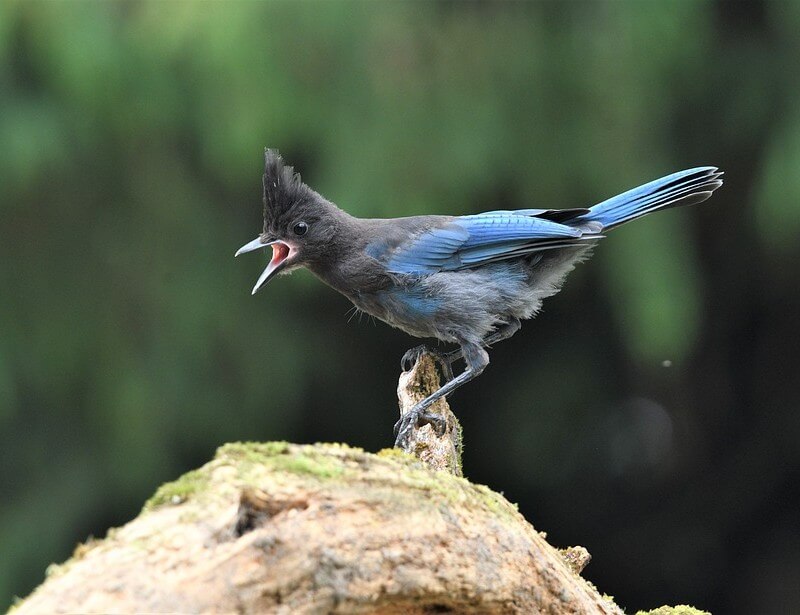
The Steller’s Jay is a year-round resident of New Mexico.
- Sayornis saya
- Size: 7″ (18 cm)
- NM Checklist Frequency High: 10% in October
- NM Checklist Frequency Low: 5% in June
Identification and Color: Steller’s Jay can have either blue or white streaks on the front of their face depending on the region. They have a long and triangular crest that is black and gray patch that leads to blue bodies. They have rounded wings and long tails. A long and straight bill with a slight hook.
Habitat and Behavior: Permanent residents in their western locations, with only some moving if in high elevations. Found in evergreen forests they can also be in some more populated areas. Mostly forages high in the trees but will occasionally forage lower or on the ground.
Diet: Steller’s Jays are omnivorous. They eat mostly vegetarian with some insect and animal matter mixed into their diet.
Western Bluebird
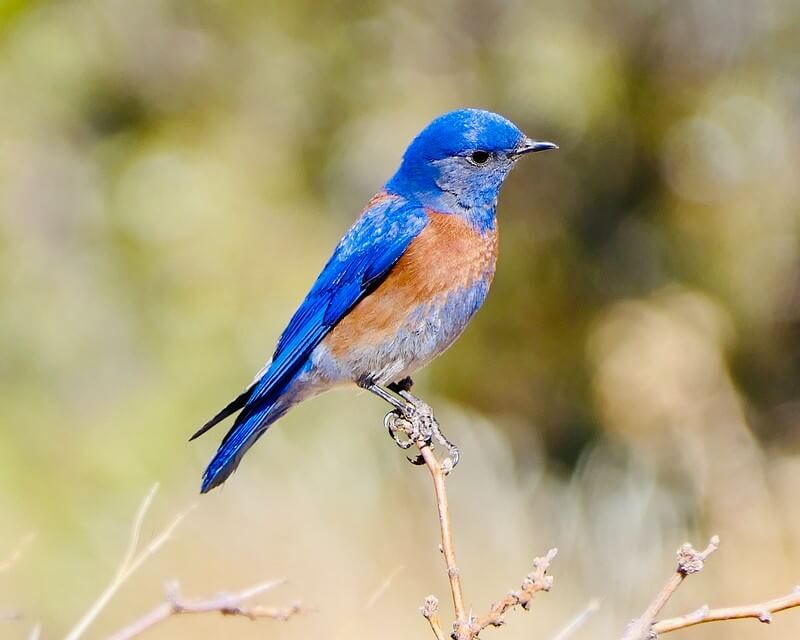
The Western Bluebird is seen year-round in New Mexico.
- Sialia mexicana
- Size: 7″ (18 cm)
- NM Checklist Frequency High: 19% in October
- NM Checklist Frequency Low: 9% in August
Identification and Color: Western Bluebird males have blue heads, wings, and tail feathers. They have an orange-brown chest and lighter belly area. Females are more grey with some blue tinge to their wings and tail. They also have a lighter orange-brown chest patch. Fairly small birds with short tails and have thin, straight bills.
Habitat and Behavior: Found in the west, most northern birds migrate and southern birds stay permanently. Like to be in open woodlands with either deciduous or coniferous trees. Can also be found in farmlands or mountainous areas. Very social birds and can be a part of big flocks. Will forage low to the ground and can catch insects mid-air.
Diet: Western Bluebirds enjoy insects like grasshoppers, caterpillars, and beetles make up the bulk of their diet.
White-breasted Nuthatch

The White-breasted Nuthatch can be found year-round in New Mexico.
- Sitta carolinensis
- Size: 6″ (15 cm)
- NM Checklist Frequency High: 23% in September
- NM Checklist Frequency Low: 15% in April
Identification and Color: A stocky short-tailed bird. Has a black cap above an all white face and breast. Blueish upper parts.
Habitat and Behavior: The White-breasted Nuthatch can be found in forests, woodlands, and parks. Known for its acrobatic abilities, it can easily move up, down, and sideways on trees.
Diet: The White-breasted Nuthatch feeds on insects, spiders, and small nuts. Relies on seeds in the winter and will often cache them in a crevice for a later date.
White-crowned Sparrow
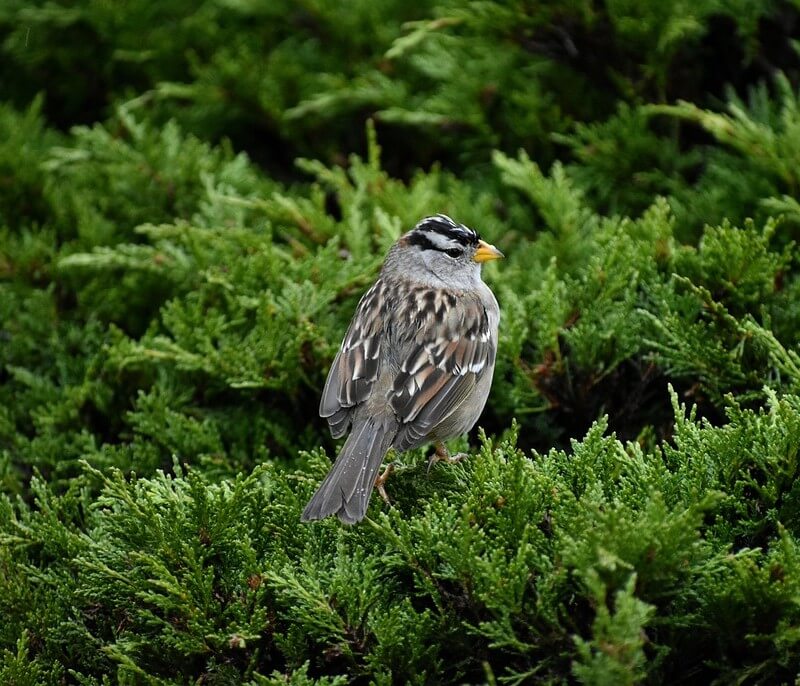
The White-crowned Sparrow is most often seen during the spring and fall months in New Mexico.
- Zonotrichia leucophrys
- Size: 6″ (15 cm)
- NM Checklist Frequency High: 41% in October
- NM Checklist Frequency Low: 1% in Summer
Identification and Color: Most White-crowned Sparrows have black and white stripes around their head. The underpart is gray. They have brown, black, and white coloring on their wings and tail. They have small, pointed bills. Long tails and rounded wings.
Habitat and Behavior: Breeds in the very far north and spends the winter in the very far south. Likes brushy places that are mixed with open and grassy areas. Usually stays low to the ground. Usually forages on the ground or in low shrubs. They usually forage in flocks.
Diet: The White-crowned Sparrow mainly enjoys seeds from weeds or grasses. Will also eat some vegetable matter and insects.
Woodhouse’s Scrub-Jay

The Woodhouse’s Scrub-Jay can be seen year-round in New Mexico.
- Aphelocoma woodhouseii
- Size: 12″ (30 cm)
- NM Checklist Frequency High: 22% in September
- NM Checklist Frequency Low: 11% in June
Identification and Color: Woodhouse’s Scrub-Jay is a long bird with long tail feathers. They are blue and grey on top, with a white throat and grey underparts. Their bill is straight and pointed.
Habitat and Behavior: Prefers open areas of pinyon or juniper. May also be in suburban regions of the mid-southwest. These vocal birds often perch in high places. They may forage alone or in flocks.
Diet: The Woodhouse’s Scrub Jay is omnivorous and will eat insects, seeds, and nuts. Will eat spiders and snails and often feed caterpillars to their young.
Yellow-rumped Warbler

The Yellow-rumped Warbler is most commonly seen in New Mexico during the spring and fall.
- Dendroica coronata
- Size: 6″ (15 cm)
- NM Checklist Frequency High: 36% in October
- NM Checklist Frequency Low: 5% in August
Identification and Color: A small warbler with a soft song, all Yellow-rumped Warblers have a patch of yellow on their sides and rump (hence the name).
Habitat and Behavior: The Yellow-rumped Warbler is typically seen in large flocks during migration in the spring and fall. Enjoys larger open wooded areas as well as brush and thickets. Most often found in trees bearing needles and cones.
Diet: Enjoys insects and berries. Difficult to attract to feeders.
Conclusion
In conclusion, New Mexico is home to a wide variety of backyard birds. These birds provide a great source of entertainment and education for birdwatchers and nature lovers alike. With the right knowledge and resources, anyone can identify and appreciate the beauty of the birds that call New Mexico home. Be sure to check out our other articles about birds in New Mexico:
Remember to keep that feeder full and have your checklist ready! Before you go, take a moment to review some of our favorite New Mexico birding resources:






